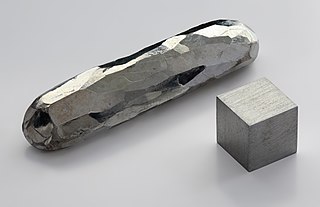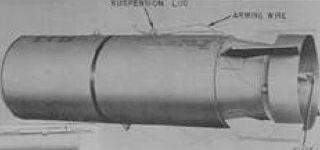Related Research Articles

Cadmium is a chemical element; it has symbol Cd and atomic number 48. This soft, silvery-white metal is chemically similar to the two other stable metals in group 12, zinc and mercury. Like zinc, it demonstrates oxidation state +2 in most of its compounds, and like mercury, it has a lower melting point than the transition metals in groups 3 through 11. Cadmium and its congeners in group 12 are often not considered transition metals, in that they do not have partly filled d or f electron shells in the elemental or common oxidation states. The average concentration of cadmium in Earth's crust is between 0.1 and 0.5 parts per million (ppm). It was discovered in 1817 simultaneously by Stromeyer and Hermann, both in Germany, as an impurity in zinc carbonate.
The United States biological weapons program officially began in spring 1943 on orders from U.S. President Franklin Roosevelt. Research continued following World War II as the U.S. built up a large stockpile of biological agents and weapons. Over the course of its 27-year history, the program weaponized and stockpiled the following seven bio-agents :

USS Tercel (AM-386) was an Auk-class minesweeper acquired by the United States Navy for the dangerous task of removing mines from minefields laid in the water to prevent ships from passing.

Operation LAC was a United States Army Chemical Corps operation which dispersed microscopic zinc cadmium sulfide (ZnCdS) particles over much of the United States and Canada in order to test dispersal patterns and the geographic range of chemical or biological weapons.

The M33 cluster bomb, also known as the (M33) Brucella cluster bomb, was a U.S. biological cluster bomb developed in the early 1950s and deployed in 1952. It was the first standardized biological weapon in the U.S. arsenal.
Zinc cadmium sulfide is a mixture of zinc sulfide (ZnS) and cadmium sulfide (CdS). It is used for its fluorescent properties. Bioaccumulation of this chemical may occur along the food chain, for example in plants and in seafood. Long-term or repeated exposures are expected to have harmful effects on the kidneys, bones, and respiratory tract, resulting in kidney impairment, osteoporosis, and chronic inflammation of the respiratory tract.

The M34 cluster bomb was the first mass-produced United States Army weapon meant to deliver the chemical agent sarin (GB). A large stockpile of M34s was destroyed between 1973 and 1976.

Operation Big Itch was a U.S. entomological warfare field test using uninfected fleas to determine their coverage and survivability as a vector for biological agents. The tests were conducted at Dugway Proving Ground in 1954.
The E86 cluster bomb was an American biological cluster bomb first developed in 1951. Though the U.S. military intended to procure 6,000 E86s, the program was halted in the first half of the 1950s.
The E23 munition was a cardboard sub-munition developed by the United States biological weapons program for use as an anti-crop weapon. The E23 underwent a conversion for use as a vector weapon and was briefly used in large-scale entomological warfare trial but technical issues forced it from the tests.

The MC-1 bomb was the first U.S. non-clustered air-dropped chemical munition. The 750-pound (340 kg) MC-1 was first produced in 1959 and carried the nerve agent sarin.
The E133 cluster bomb was a U.S. biological weapon developed during the Cold War.
The E48 particulate bomb was a U.S. biological sub-munition designed during the 1950s for use with the E96 cluster bomb.
Operation Dew refers to two separate field trials conducted by the United States in the 1950s. The tests were designed to study the behavior of aerosol-released biological agents.
The Vigo Ordnance Plant, also known as the Vigo Chemical Plant or simply Vigo Plant, was a United States Army facility built in 1942 to produce conventional weapons. In 1944 it was converted to produce biological agents for the U.S. bio-weapons program. Although the plant never actually produced bio-weapons before the end of World War II, it did produce 8000 pounds of an anthrax simulant. After the war, the plant was transferred to Pfizer, who operated it until the plants closure in 2008.
Operation Night Train was part of a series of chemical and biological warfare tests overseen by the Deseret Test Center as part of Project 112. The test was conducted near Fort Greely, Alaska from November 1963 to January 1964. The primary purpose of Night Train was to study the penetration of an arctic inversion by a biological aerosol cloud. The test's first purpose was to study the downwind travel and diffusion of this cloud when disseminated into different arctic meteorological regimes. All documents about Night Train were considered classified by the US military until 2002, when the Department of Defense (DOD) released medically relevant information of all the chemical and biological warfare agent tests conducted under Project 112.
The Dorset Biological Warfare Experiments were a series of experiments conducted between 1953 and 1975 to determine the extent to which a single ship or aircraft could dispense biological warfare agents over the United Kingdom. The tests between 1971 and 1975 were known as the DICE trials. The tests were conducted by scientists from Porton Down, initially using zinc cadmium sulfide (ZnCdS) as a simulated agent. Early results clearly showed that one aircraft flying along the coast while spraying its agent could contaminate a target over 100 miles away, over an area of 10,000 square miles. This method of biological warfare attack and the test program to study it was known as the Large Area Coverage (LAC) concept.
Operation Sea-Spray was a 1950 U.S. Navy secret biological warfare experiment in which Serratia marcescens and Bacillus globigii bacteria were sprayed over the San Francisco Bay Area in California, in order to determine how vulnerable a city like San Francisco may be to a bioweapon attack.
Quantum dots (QDs) are semiconductor nanoparticles with a size less than 10 nm. They exhibited size-dependent properties especially in the optical absorption and the photoluminescence (PL). Typically, the fluorescence emission peak of the QDs can be tuned by changing their diameters. So far, QDs were consisted of different group elements such as CdTe, CdSe, CdS in the II-VI category, InP or InAs in the III-V category, CuInS2 or AgInS2 in the I–III–VI2 category, and PbSe/PbS in the IV-VI category. These QDs are promising candidates as fluorescent labels in various biological applications such as bioimaging, biosensing and drug delivery.
References
- 1 2 3 U.S. National Research Council, Subcommittee on Zinc Cadmium Sulfide. Toxicologic Assessment of the Army's Zinc Cadmium Sulfide Dispersion, (Google Books), National Academies Press, 1997, pp. 44-52, ( ISBN 0309057833).
- 1 2 Committee on Foreign Affairs, Subcommittee on National Security Policy and Scientific Developments. "U.S. Chemical Warfare Policy", (Google Books), 93rd U.S. Congress - 2nd Session, U.S. Government Printing Office, 1974, p. 340.